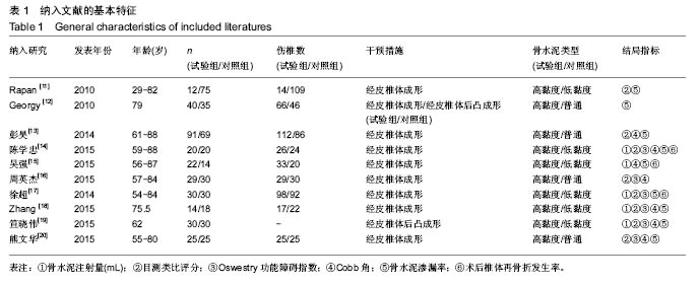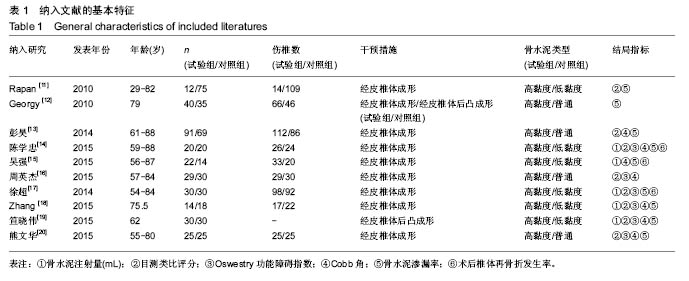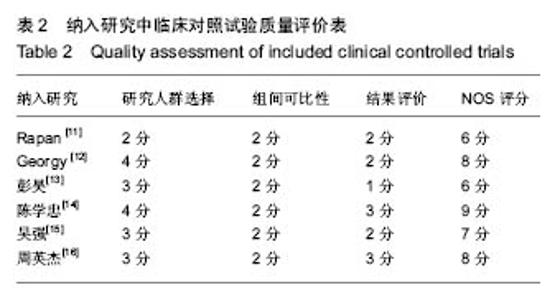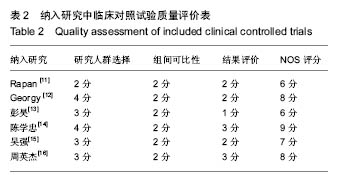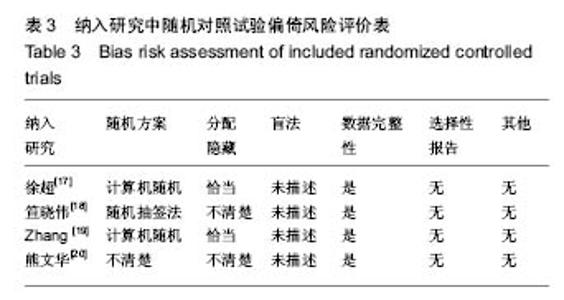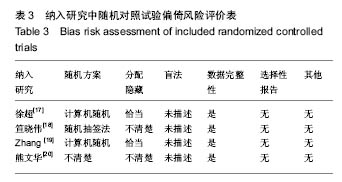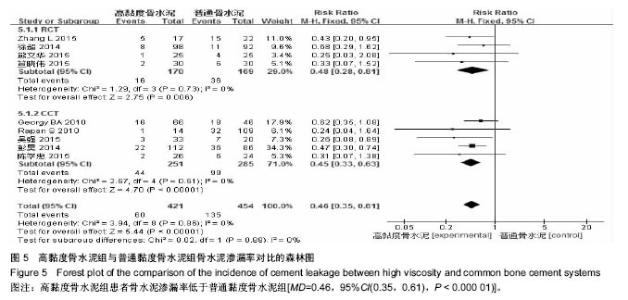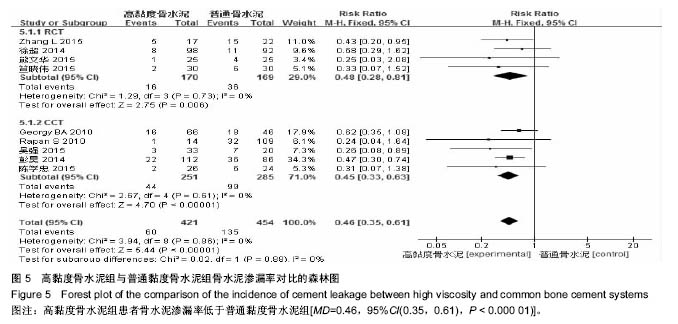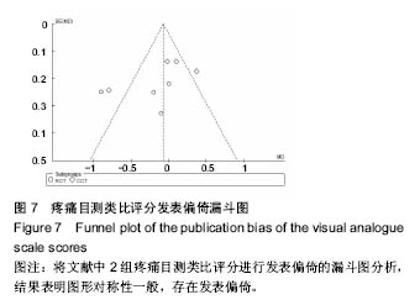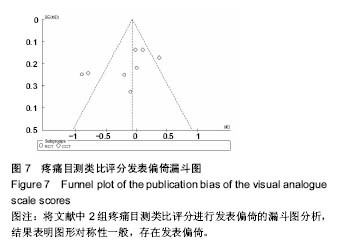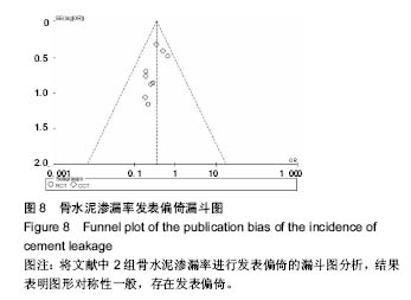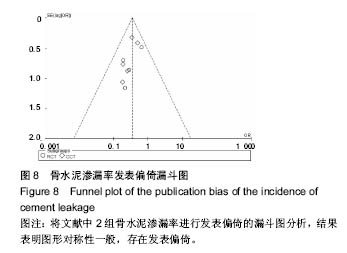Chinese Journal of Tissue Engineering Research ›› 2017, Vol. 21 ›› Issue (2): 322-328.doi: 10.3969/j.issn.2095-4344.2017.02.028
High viscosity versus common viscosity bone cement systems in the treatment of osteoporotic vertebral compressive fractures: a Meta-analysis
- Department of Orthopaedics, the People’s Hospital of Guangxi Zhuang Autonomous Region, Nanning 530021, Guangxi Zhuang Autonomous Region, China
-
Received:2016-10-28Online:2017-01-18Published:2017-02-27 -
Contact:Wei Jian-xun, Master, Chief physician, Master’s supervisor, Department of Orthopaedics, the People’s Hospital of Guangxi Zhuang Autonomous Region,Nanning 530021, Guangxi Zhuang Autonomous Region, China -
About author:Mu Xiao-ping, Studying for master’s degree, Department of Orthopaedics, the People’s Hospital of Guangxi Zhuang Autonomous Region,Nanning 530021, Guangxi Zhuang Autonomous Region, China Yi Wei-lin, Department of Orthopaedics, the People’s Hospital of Guangxi Zhuang Autonomous Region,Nanning 530021, Guangxi Zhuang Autonomous Region, China Mu Xiao-ping and Yi Wei-lin contributed equally to this work.
CLC Number:
Cite this article
Mu Xiao-ping, Yi Wei-lin, Wei Jian-xun, Ou Yu-fu, Li Zhu-hai.
share this article

2.3.3 Oswestry功能障碍指数 共3篇随机对照试 验[17,19-20]及2篇临床对照试验[15-16]报告高黏度骨水泥与普通骨水泥对比的Oswestry功能障碍指数。各研究间有统计学异质性(P < 0.000 01,I 2=86%),采用随机效应模型。随机对照试验的分析结果表明,2组在Oswestry功能障碍指数上差异有显著性意义[MD=-2.80,95%CI(-4.95,-0.65)]。但临床对照试验的分析结果表明,2组在Oswestry功能障碍指数上差异无显著性意义[MD=-3.73,95%CI (-10.79,3.33)。亚组分析综合结果显示,2组在Oswestry功能障碍指数得分差异有显著性意义[MD=-2.99,95%CI(-5.85,-0.13),P < 0.000 01,见图3]。"

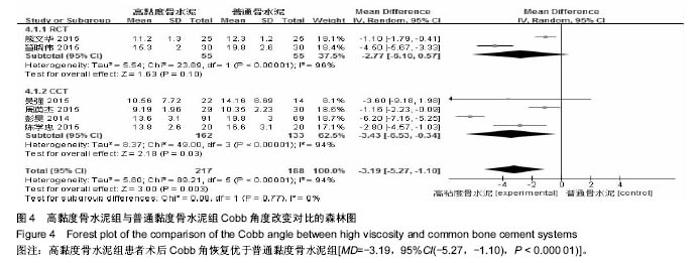
2.3.4 Cobb角 共2篇随机对照试验[19-20]、4篇临床对照试验[13-16]报告高黏度骨水泥与普通骨水泥对比的Cobb角度改变。各研究间有统计学异质性(P < 0.000 01,I 2 = 94%),采用随机效应模型。随机对照试验的分析结果表明,2组在Cobb角度改变方面差异无显著性意义[MD=-2.77,95%CI(-6.10,0.57)]。但临床对照试验的分析结果表明,2组在Cobb角度改变方面差异有显著性意义[MD=-3.43,95%CI(-6.53,-0.34)]。亚组分析综合结果显示,2组在Cobb角度改变方面差异有显著性意义[MD=-3.19,95%CI(-5.27,-1.10),P < 0.000 01,见图4]。"
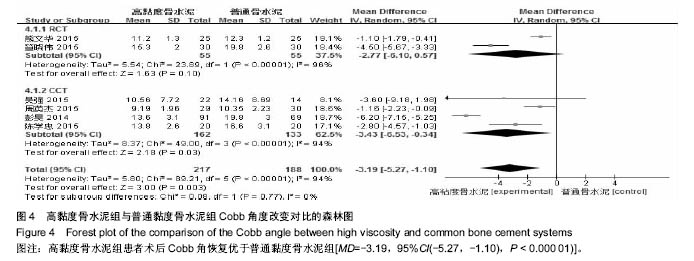
| [1]Wong CC, Mc Girt MJ. Vertebral compression fractures: a review of current management and multimodal therapy.J Multidiscip Healthc. 2013;6: 205-214.[2]Old JL, Calvert M. Vertebral compression fractures in the elderly. Am Fam Phys. 2004;69(1):111-116.[3]Zhai WF, Jia YW, Wang JJ, et al. The clinical effect of percutaneous kyphoplasty for the treatment of multiple osteoporotic vertebral compression fractures and the prevention of new vertebral fractures. Int J Clin Exp Med. 2015;8(8): 13473-13481.[4]Sakuma M, Endo N, Oinuma T, et al. Incidence of osteoporotic fractures in Sado,Japan in 2010. J Bone Miner Metab. 2014;32:200-205.[5]Anderson PA, Froyshteter AB, Tontz Jr WL. Meta-analysis of vertebralaugmentation compared with conservative treatment for osteoporotic spinalfractures. J Bone Miner Res. 2013;28:372-382.[6]Martin DJ, Rad AE, Kallmes DF. Prevalence of extravertebral cement leakage after vertebroplasty: procedural documentation versus CT detection. Acta Radiol. 2012;53:569-572.[7]Zhang L, Liu ZJ, Wang JC, et al. Unipedicular versus bipedicular percutaneous vertebroplasty for osteoporotic vertebral compression fractures:a prospective randomized study. BMC Musculoskelet Disord. 2015;16: 145.[8]Lador R, Liberman S, Ben-Galim P, et al. A cadaverstudy to compare vertebral augmentation with a high-viscosity cement toaugmentation with conventional lower-viscosity cement. J Spinal Disord Tech.2013;26:68-73.[9]Furlan AD, Pennick V, Bombardier C, et al.Updatedmethod guidelines for systematic reviews in the Cochrane BackReview Group. Spine (Phila Pa 1976). 2009;34(18):1929-1941.[10]Stang A. Critical evaluation of the Newcastle-Ottawa scale for the assessment of the quality of nonrandomized studies in meta-analyses. Eur J Epidemiol. 2010;25(9):603-605.[11]Rapan S, Jovanovic S, Gulan G, et al. Vertebroplasty – high viscosity cement versus low viscosity cement. Coll. Antropol. 2010;34 (3) :1063-1067.[12]Georgy BA. Clinical experience with high-viscosity cementsfor percutaneous vertebral body augmentation:occurrence, degree, and location of cementleakage compared with kyphoplasty.AJNR Am J Neuroradiol. 2010;31(3):504-508. [13]彭昊,谭俊峰,刘洋,等.高黏度骨水泥与传统骨水泥治疗骨质疏松性椎体压缩性骨折的疗效比较[J].生物医学工程与临床, 2014, 18(4):344-348.[14]陈学忠,董玮,奚江明,等.高黏度与低黏度骨水泥在椎体成形术中应用的临床对比研究[J].成都医学院学报,2015,10(2):186-189.[15]吴强,包拥政,莫世赞,等.高粘度与低粘度骨水泥椎体成形术治疗OVCFs的疗效观察[J].国际医药卫生导报,2015,21(1):29-31.[16]周英杰,赵鹏飞,郑怀亮,等.两种骨水泥应用于老年胸腰椎骨折椎体成形术的疗效观察[J].中国矫形外科杂志, 2015,23(4):364-367.[17]徐超,伊力哈木•托合提,李国华,等.高粘度与低粘度骨水泥PVP治疗骨质疏松椎体压缩骨折的疗效和并发症[J].中国脊柱脊髓志,2014,24(10):900-905.[18]Zhang L, Wang JC, Feng XM, et al. A comparison of high viscosity bone cement and low viscositybone cement vertebroplasty for severe osteoporotic vertebralcompression fractures.Clin Neurol Neurosurg. 2015;129:10-16.[19]笪晓伟,李启中,区杰雄,等.高黏度与低黏度骨水泥在经皮椎体后凸成形术中的应用比较[J].中国骨科临床与基础研究杂志, 2015, 7(2):79-83.[20]熊文华,杨云海,林卓锋,等.高粘度骨水泥在治疗骨质疏松性椎体压缩骨折中的临床应用[J].河北医学,2015,21(5):774-777.[21]Chen C, Li DH, Wang ZG, et al. Safety and Efficacy Studies of Vertebroplasty, Kyphoplasty, and Mesh-Container-Plasty for the Treatment of Vertebral Compression Fractures: Preliminary Report. PLoS ONE. 2016; 11(3): e0151492.[22]Ee GWW, Lei J, Guo CM, et al. Comparison of clinical outcomes and radiographic measurements in four different treatment modalities for osteoporotic compression fractures: retrospective analysis. J Spinal Disord Tech. 2015;28(6):E328-335.[23]Yang YM, Ren ZW, Ma W, et al. Current status of percutaneous vertebroplasty and percutaneous kyphoplasty-a review. Med Sci Monit. 2013;19: 826-836.[24]Habib M, Serhan H, Marchek C, et al. Cement leakage andfilling pattern study of low viscous vertebroplastic versus highviscous confidence cement. SAS J. 2010;4(1):26-33.[25]李春海,刘尚礼,叶伟,等.高黏度骨水泥在经皮椎体成形术中的应用[J].中华骨科杂志,2007,27(4):259-262.[26]申勇,任虎,张英泽,等.经皮椎体后凸成形术治疗骨质疏松性椎体压缩骨折骨水泥渗漏的相关因素分析[J].中国修复重建外科杂志, 2010,24(1): 27-31.[27]Wang CH,Ma JZ,Zhang CC,et al. Comparison of high -viscosity cement vertebroplasty and balloon kyphoplasty for the treatment of osteoporotic vertebral compression fractures. Pain Physician. 2015;18(2):E187-194.[28]王峙锦,王宏,马凯,等.高粘度骨水泥PVP 或PKP 结合体位复位治疗胸腰椎骨质疏松性椎体压缩骨折的疗效观察[J].中国骨关节损伤杂志,2016,31(6):1-2. |
| [1] | Yao Xiaoling, Peng Jiancheng, Xu Yuerong, Yang Zhidong, Zhang Shuncong. Variable-angle zero-notch anterior interbody fusion system in the treatment of cervical spondylotic myelopathy: 30-month follow-up [J]. Chinese Journal of Tissue Engineering Research, 2022, 26(9): 1377-1382. |
| [2] | Jiang Huanchang, Zhang Zhaofei, Liang De, Jiang Xiaobing, Yang Xiaodong, Liu Zhixiang. Comparison of advantages between unilateral multidirectional curved and straight vertebroplasty in the treatment of thoracolumbar osteoporotic vertebral compression fracture [J]. Chinese Journal of Tissue Engineering Research, 2022, 26(9): 1407-1411. |
| [3] | An Weizheng, He Xiao, Ren Shuai, Liu Jianyu. Potential of muscle-derived stem cells in peripheral nerve regeneration [J]. Chinese Journal of Tissue Engineering Research, 2022, 26(7): 1130-1136. |
| [4] | Zhang Jinglin, Leng Min, Zhu Boheng, Wang Hong. Mechanism and application of stem cell-derived exosomes in promoting diabetic wound healing [J]. Chinese Journal of Tissue Engineering Research, 2022, 26(7): 1113-1118. |
| [5] | He Yunying, Li Lingjie, Zhang Shuqi, Li Yuzhou, Yang Sheng, Ji Ping. Method of constructing cell spheroids based on agarose and polyacrylic molds [J]. Chinese Journal of Tissue Engineering Research, 2022, 26(4): 553-559. |
| [6] | He Guanyu, Xu Baoshan, Du Lilong, Zhang Tongxing, Huo Zhenxin, Shen Li. Biomimetic orientated microchannel annulus fibrosus scaffold constructed by silk fibroin [J]. Chinese Journal of Tissue Engineering Research, 2022, 26(4): 560-566. |
| [7] | Chen Xiaoxu, Luo Yaxin, Bi Haoran, Yang Kun. Preparation and application of acellular scaffold in tissue engineering and regenerative medicine [J]. Chinese Journal of Tissue Engineering Research, 2022, 26(4): 591-596. |
| [8] | Kang Kunlong, Wang Xintao. Research hotspot of biological scaffold materials promoting osteogenic differentiation of bone marrow mesenchymal stem cells [J]. Chinese Journal of Tissue Engineering Research, 2022, 26(4): 597-603. |
| [9] | Shen Jiahua, Fu Yong. Application of graphene-based nanomaterials in stem cells [J]. Chinese Journal of Tissue Engineering Research, 2022, 26(4): 604-609. |
| [10] | Zhang Tong, Cai Jinchi, Yuan Zhifa, Zhao Haiyan, Han Xingwen, Wang Wenji. Hyaluronic acid-based composite hydrogel in cartilage injury caused by osteoarthritis: application and mechanism [J]. Chinese Journal of Tissue Engineering Research, 2022, 26(4): 617-625. |
| [11] | Li Hui, Chen Lianglong. Application and characteristics of bone graft materials in the treatment of spinal tuberculosis [J]. Chinese Journal of Tissue Engineering Research, 2022, 26(4): 626-630. |
| [12] | Gao Cangjian, Yang Zhen, Liu Shuyun, Li Hao, Fu Liwei, Zhao Tianyuan, Chen Wei, Liao Zhiyao, Li Pinxue, Sui Xiang, Guo Quanyi. Electrospinning for rotator cuff repair [J]. Chinese Journal of Tissue Engineering Research, 2022, 26(4): 637-642. |
| [13] | Guan Jian, Jia Yanfei, Zhang Baoxin , Zhao Guozhong. Application of 4D bioprinting in tissue engineering [J]. Chinese Journal of Tissue Engineering Research, 2022, 26(3): 446-455. |
| [14] | Huang Bo, Chen Mingxue, Peng Liqing, Luo Xujiang, Li Huo, Wang Hao, Tian Qinyu, Lu Xiaobo, Liu Shuyun, Guo Quanyi . Fabrication and biocompatibility of injectable gelatin-methacryloyl/cartilage-derived matrix particles composite hydrogel scaffold [J]. Chinese Journal of Tissue Engineering Research, 2022, 10(16): 2600-2606. |
| [15] | Liu Jiali, Suo Hairui, Yang Han, Wang Ling, Xu Mingen. Influence of lay-down angles on mechanical properties of three-dimensional printed polycaprolactone scaffolds [J]. Chinese Journal of Tissue Engineering Research, 2022, 10(16): 2612-2617. |
| Viewed | ||||||
|
Full text |
|
|||||
|
Abstract |
|
|||||
